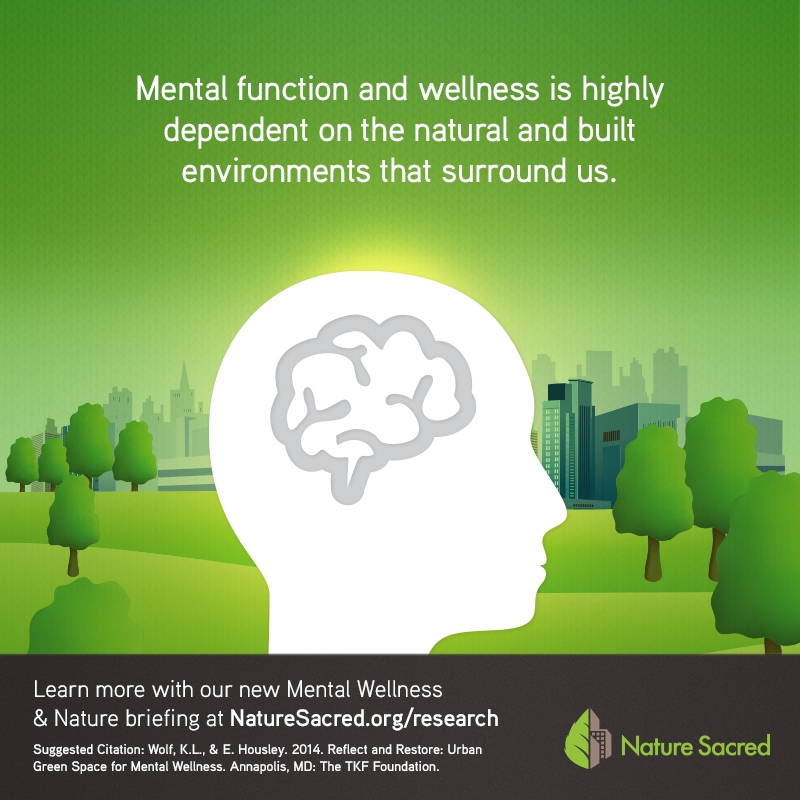Every individual realizes his or her own potential.
“Decades ago Abraham Maslow described the concept of a hierarchy of human needs. The major idea is that people have basic needs such as food, water, and shelter. Once these needs are satisfied, a person, through learning, work, constructive action, and relationships with other people, ascends a series of stages to self-actualization. This pursuit of one’s potential is not necessarily step-wise. One can work toward having clean water, and at the same time pursue acts of creativity or social interactions that support one’s self-esteem. Rarely considered on these terms, encounters with nature and involvement in stewardship within one’s community may help a person to satisfy both basic and more abstract human needs, particularly those that involve mental wellness and function.
- Urban nature, when incorporated into community planning and building design, provides calming and inspiring environments and can encourage learning, inquisitiveness, and alertness1,2.
- Using national data for 10,000 people in the UK, a recent study found that, on average, individuals have both lower mental distress and higher well-being when living in urban areas with more green spaces3.
- Those people who relocated to homes in greener areas had significantly better mental health for all of the 3 years of monitoring following the move. Moving to greener urban areas was associated with sustained mental health improvements in a study group of more than 500 people4.
- EEG recordings showed evidence of lower frustration and higher meditation when in green space, versus when moving within retail and commercial areas having no trees5. Happiness, or the presence of a positive emotional mindset, broadens how a person thinks about and acts in the daily flow of life’s efforts, creating positive intellectual and psychological resources.
- Findings in medical research support the benefits of mindfulness activities6. During relaxing activities such as light walking, tai-chi, yoga, meditation, and exercise, even prayer and belief, the brain shifts from releasing stress hormones to the production of endorphins and dopamine. When a person engages in such activities and within environments that she believes contribute to health and wellbeing, the placebo effect[1] supports mental wellness.
- A study compared meditative and athletic walking, in both forest and indoor settings7. Meditative walking had greater effectiveness on positive psychological effects than athletic walking did in the same environment. Also, walking in the forest increased happiness to a greater degree than walking in the gymnasium at the same pace. Meditative walking in the forest was the most effective at increasing happiness.
- There is interest in the developmental benefits of nature experiences for children. Contact with nature may help children to develop cognitive, emotional, and behavioral connections to their nearby social and biophysical environments. Nature experiences can potentially encourage imagination and creativity, support feelings of self-worth, aid cognitive and intellectual development, enhance ability to concentrate and exercise self-discipline, and encourage positive social relationships8,9,10,11,12,13,14.”
For more about the healing power of nature: Reflect and Restore – Urban Green Space for Mental Wellness
[1] The placebo effect is itself a powerful drug. It is not a trick found in research methods. It is the act of placing one’s mind and body in such a state that the brain is triggered to enact healing pathways. As much as 30-50% of healing in research studies is attributed to the placebo effect6.
1Beatley, T. 2010. Biophilic Cities: Integrating Nature Into Urban Design and Planning. Washington DC, Island Press.
2 Kaplan, R., & S. Kaplan. 1989. The Experience of Nature: A Psychological Perspective. Cambridge University Press, New York.
3 White, M.P., I. Alcock, B.W. Wheeler, & M.H. Depledge. 2013. Would you be happier living in a greener urban area? A fixed-effects analysis of panel data. Psychological Science 24, 6: 920-28.
4 Alcock, I., M.P. White, B.W. Wheeler, L.E. Fleming, & M.H. Depledge. 2014. Longitudinal effects on mental health of moving to greener and less green urban areas. Environmental Science & Technology 48, 2: 1247-255.
5 Aspinall, P., P. Mavros, R. Coyne, and J. Roe. 2013 (online). The urban brain: Analysing outdoor physical activity with mobile EEG. British Journal of Sports Medicine.
6 Sternberg, E.M. 2009. Healing Spaces: The Science of Place and Well-being. Belknap Press, Cambridge MA.
7 Shin, Y.K., K. Jung-Choi, Y.J. Son, J.W. Koo, J.A. Min, & J.H. Chae. 2013. Differences of psychological effects between meditative and athletic walking in a forest and gymnasium. Scandinavian Journal of Forest Research 28, 1: 64-72.
8 Heerwagen, J.H., & G.H. Orians. 2002. The ecological world of children. In: P.H.J. Kahn, & S.R. Kellert (eds.), Children and Nature: Psychological, Sociocultural, and Evolutionary Investigations. MIT Press, Cambridge MA, pp. 29-64.
9 Kahn Jr., P.H., & S.R. Kellert. 2002. Children and Nature: Psychological, Sociocultural, and Evolutionary Investigations. MIT Press, Cambridge MA.
10 Kirkby, M. 1989. Nature as refuge in children’s environments. Children’s Environments Quarterly 6: 7-12.
11 Taylor, A.F., F.E. Kuo, & W.C. Sullivan. 2002. Views of nature and self-discipline: Evidence from inner city children. Journal of Environmental Psychology 22, 1-2: 49-63.
12 Wells, N.M., & G.W. Evans. 2003. Nearby nature: A buffer of life stress among rural children. Environment and Behavior 35, 3: 311-330.
13 Wells, N.M. 2000. At home with nature: Effects of “greenness” on children’s cognitive functioning. Environment and Behavior 32, 6: 775-795.
14 Coley, R.L., W.C. Sullivan, & F.E. Kuo. 1997. Where does community grow? Environment and Behavior 29: 468.

